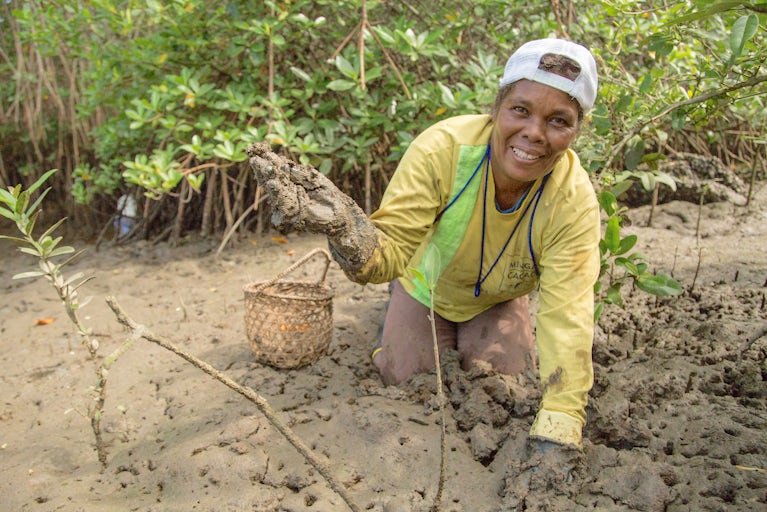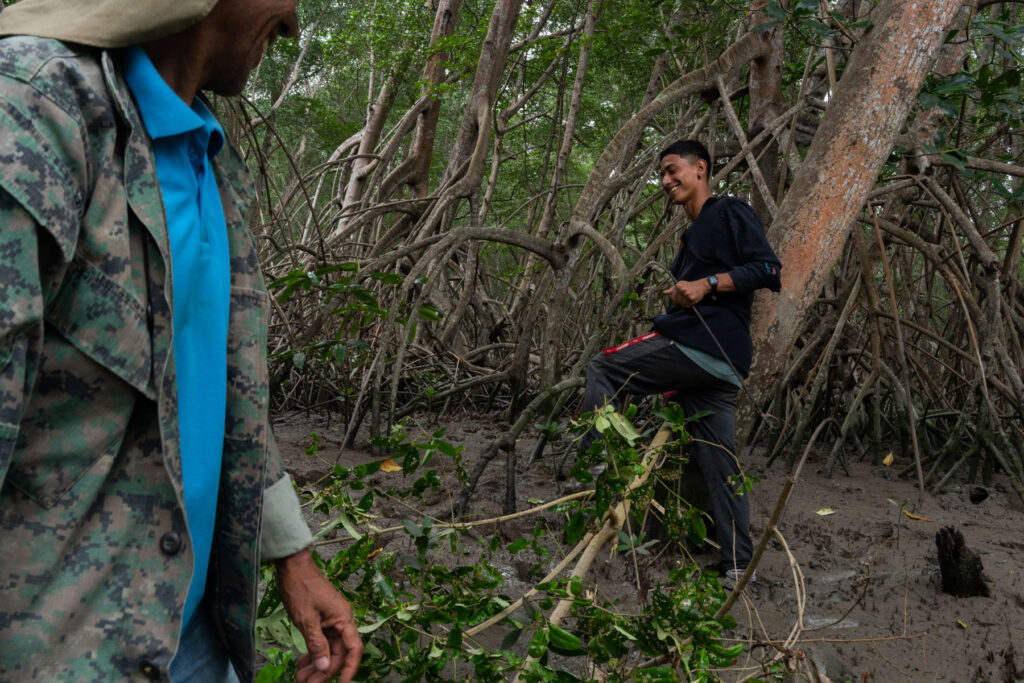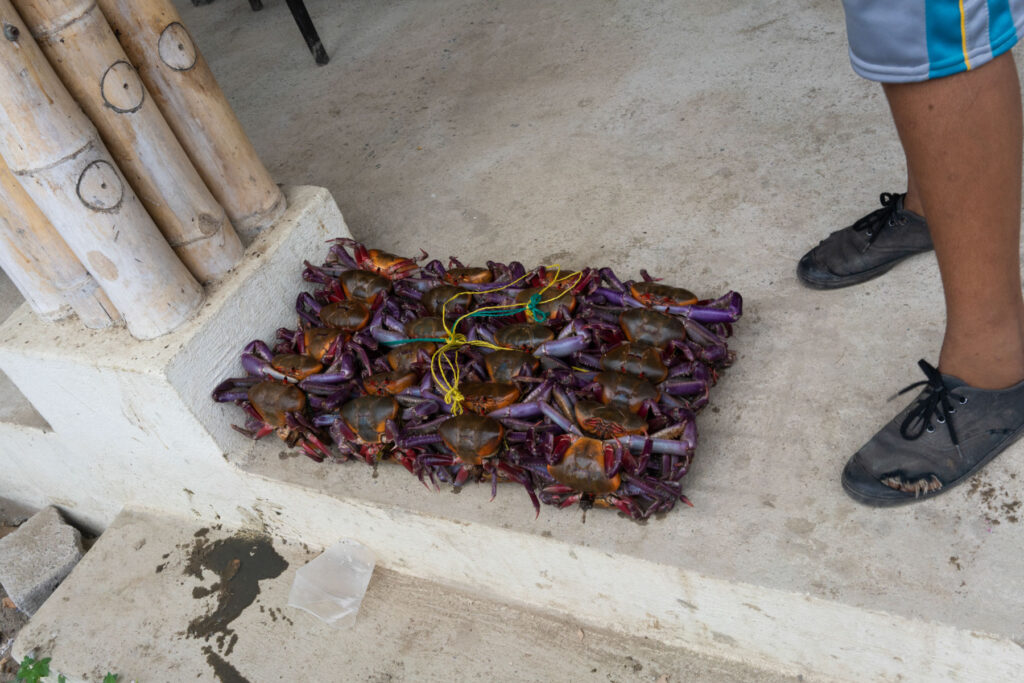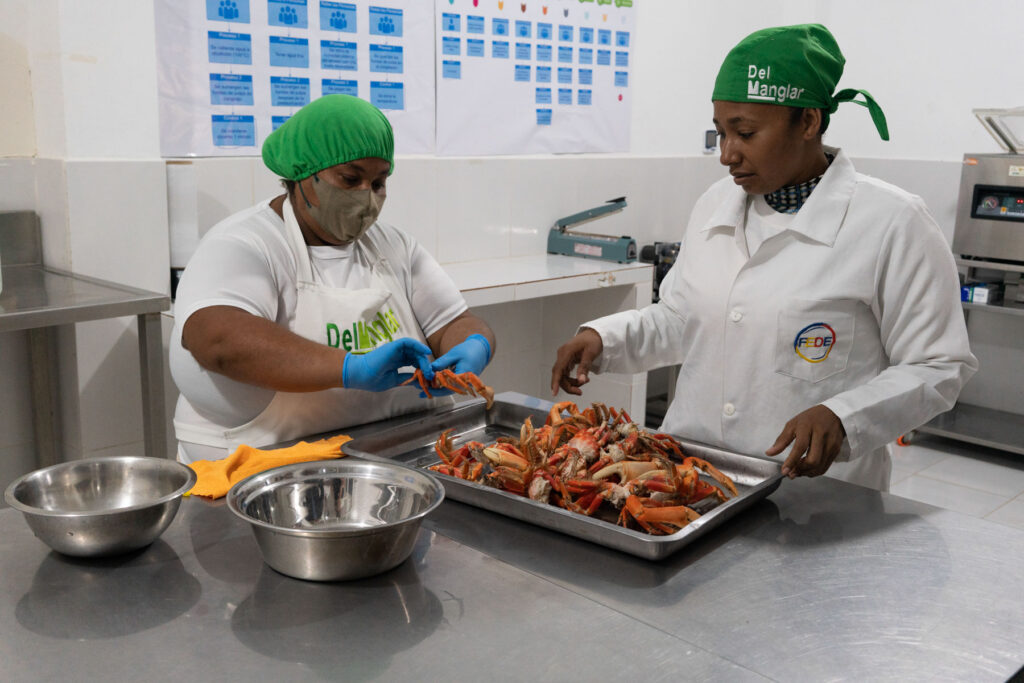
Heifer Ecuador Applauds Country's Progress Toward Nature-Friendly Future
By Rosa Rodriguez | September 5, 2023
In the vibrant mangrove ecosystem of Naranjal, in Ecuador’s western Guayaquil province, Clemente Cáceres’ workday begins at 4 a.m. Clemente is president of a local farmers association, Cooperativa Producción Pesquera Nuevo Porvenir, and earns his living as a shellfish collector. Each day, he leaves his house early and catches a morning bus; by 6 a.m., he is already at the coastal village of Nuevo Porvenir to start collecting crabs.
He boards a motorboat with two other companions, and the group begins navigating the Naranjal River. During the trip, he sees the diversity of the environment: the surrounding tropical dry forest, several species of birds, and two dolphins, known as bottle-nosed dolphins, that pass on one side of the boat.
After about 40 minutes, the river transport stops on a bank. The collectors get off and maneuver over fallen branches until they reach the place where they bury themselves to their knees in the muddy soil that serves as an ideal habitat for crabs.
There, they start collecting. But there are rules to harvest from the mangroves responsibly, without disrupting its delicate ecological balance. “We protect the species,” Clemente explained. “We only collect males and the appropriate size and we respect the closed seasons.”

Preserving the mangrove ecosystem is critical for the region’s economic and environmental stability, as its natural systems are an important source of nutrition, livelihoods and climate resilience. As small-scale native collectors, Clemente and his peers serve not only as producers of food, but as influential stewards of the environment their community relies on. Together, their efforts to advance a sustainable crab market are building a foundation for food sovereignty, biodiversity and resilience to flourish together.
Ecuador’s mangrove forests — dense networks of mangrove trees that grow on the waterlogged shoreline — cover more than 980 square miles along the country’s coast. These coastal ecosystems host an abundance of marine life and provide immense environmental benefits, including carbon sequestration, water purification, and erosion and flood prevention.
Local community members, like Clemente and others in his cooperative, also earn vital income by collecting and selling clams and crabs from the mangrove pools.
In recent decades, the ecosystem has faced threats such as logging, pollution and expansion of commercial shrimp farms, but locally led conservation efforts and other reforms have helped curb the loss.
Heifer Ecuador has partnered with collectors in the area since 2015, providing organizational, production, distribution and marketing support to strengthen ecologically friendly mangrove livelihoods. We connect native collectors to trusted markets so they can earn enough without depleting the environment, offer technical assistance and guidance and have helped them develop community nurseries for mangrove reforestation.
In August 2023, the Ecuadorian government granted custodial rights to four Heifer-supported farmer associations, including Cooperativa Producción Pesquera Nuevo Porvenir, to continue this work. Currently, Clemente and his peers are the legal custodians of 3,800 hectares of mangroves, nearly 9,400 acres of the coastal forest.
“There are truly many living beings there — crabs, birds, reptiles, insects,” Clemente explained. “It’s our home. We have obligations to the Ministry of the Environment that we must fulfill. We take care of it.”
In 2017, with the support of Heifer Ecuador, Cooperativa Producción Pesquera Nuevo Porvenir and three other associations in Guayas province — Seis de Julio, Balao and Las Huacas — created a collection and processing company called Mansur del Manglar with financing from the Inter-American Development Bank and Heifer International.
Mansur del Manglar purchases crabs at a standard rate of $10 each, an improvement from the $9 received outside the plant or through intermediaries. The company also supports processing raw material into more profitable products, such as packaged crab and crab flour, and has strict sanitary standards, enabling small-scale collectors to better participate in Ecuador’s valuable domestic crab market and growing export market.
“For us as an organization, having the processing plant has been very nice,” Clemente reflected. “We don’t just sell what we collect but we also add value to it.”
Each day, he collects up to the legal quota of 60 crabs per fisherman so as not to strain the ecosystem — a limit native collectors can better manage with access to stable, fair payments and opportunities to increase their income through Mansur del Manglar.

By 11 a.m. Clemente’s boat returns to the small port of Nuevo Porvenir, where he and the other collectors who have finished their work will deliver their crab harvest directly to the company. One of its four collection and processing centers — where the shellfish are received and cleaned, then cooked, pulped, packaged and pasteurized, before labeling, freezing and final quality control — is located in this sector.
The safety measures for operating the plant are strict: The workers wear boots and hats to cover their hair, and there is a disinfection area at the door for shoes and clothing. The company sells vacuum-packed crab pulp and claws, among its other products, producing 360 pounds of crab pulp, 120 bags of six claws each, and 300 pounds of shell per week. Each pound of pulp earns the company about $16.
Much of the operations at Mansur del Manglar are conducted by the collectors’ wives. This work provides income for their families and is a step toward economic independence for the women in the associations, explained Patricia Flores, plant manager of the Seis de Julio Association of Cangrejeros.

In total, harvesting and processing for the company generate jobs for more than 400 families. The enterprise currently partners with 25 different buyers, companies and distributors, with its products reaching restaurants and hotel chains in Guayaquil, Samborondón, Quito, Ambato, Cuenca, Portoviejo and Santa Elena. Work is being done to improve the products’ traceability and enable customers to identify the harvester, building a base of conscious buyers. The company also plans to export to the United States and some European countries.
Meanwhile, preservation of the mangroves continues. As an additional measure, Heifer-supported farmer associations have introduced mangrove honey as a supplementary product. By placing hives in the coastal forest and conducting beekeeping during the closed season for harvesting crustaceans, collectors earn additional income and help reduce pressure on the environment.
“It’s a huge challenge to put a brand on the market,” Clemente said, referring to the work of Mansur del Manglar. The associations face a competitive industry, but their commitment to practices that balance food production and ecology continues to shape a resilient future for their community.
“Our pulp protects the mangroves and the resources,” he added.
Cart is empty
Success!
Please be patient while we send you to a confirmation page.
We are unable to process your request. Please try again, or view common solutions on our help page. You can also contact our Donor Services team at 855.9HUNGER (855.948.6437).
Covering the transaction fee helps offset processing and administrative fees that we incur through taking payments online.